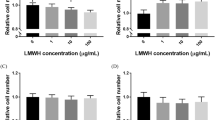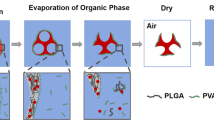Abstract
Cardiac dysfunction following acute myocardial infarction is a major cause of death in the world and there is a compelling need for new therapeutic strategies. In this report we demonstrate that a direct cardiac injection of drug-loaded microparticles, formulated from the polymer poly(cyclohexane-1,4-diylacetone dimethylene ketal) (PCADK), improves cardiac function following myocardial infarction. Drug-delivery vehicles have great potential to improve the treatment of cardiac dysfunction by sustaining high concentrations of therapeutics within the damaged myocardium. PCADK is unique among currently used polymers in drug delivery in that its hydrolysis generates neutral degradation products. We show here that PCADK causes minimal tissue inflammatory response, thus enabling PCADK for the treatment of inflammatory diseases, such as cardiac dysfunction. PCADK holds great promise for treating myocardial infarction and other inflammatory diseases given its neutral, biocompatible degradation products and its ability to deliver a wide range of therapeutics.
This is a preview of subscription content, access via your institution
Access options
Subscribe to this journal
Receive 12 print issues and online access
$259.00 per year
only $21.58 per issue
Buy this article
- Purchase on Springer Link
- Instant access to full article PDF
Prices may be subject to local taxes which are calculated during checkout





Similar content being viewed by others
References
Anversa, P. Myocyte death in the pathological heart. Circ. Res. 86, 121–124 (2000).
Anversa, P., Leri, A. & Kajstura, J. Cardiac regeneration. J. Am. Coll. Cardiol. 47, 1769–1776 (2006).
Bolli, R. Oxygen-derived free radicals and myocardial reperfusion injury: An overview. Cardiovasc. Drugs ther. 5, 249–268 (1991).
Bolli, R. et al. Direct evidence that oxygen-derived free radicals contribute to postischemic myocardial dysfunction in the intact dog. Proc. Natl Acad. Sci. USA 86, 4695–4699 (1989).
Kumar, S., Boehm, J. & Lee, J. C. p38 MAP kinases: key signalling molecules as therapeutic targets for inflammatory diseases. Nat. Rev. Drug. Discov. 2, 717–726 (2003).
Lee, J. C. et al. Inhibition of p38 MAP kinase as a therapeutic strategy. Immunopharmacology 47, 185–201 (2000).
Peifer, C., Wagner, G. & Laufer, S. New approaches to the treatment of inflammatory disorders small molecule inhibitors of p38 MAP kinase. Curr. Top. Med. Chem. 6, 113–149 (2006).
Davis, M. E., Hsieh, P. C., Grodzinsky, A. J. & Lee, R. T. Custom design of the cardiac microenvironment with biomaterials. Circ. Res. 97, 8–15 (2005).
Christman, K. L. & Lee, R. J. Biomaterials for the treatment of myocardial infarction. J. Am. Coll. Cardiol. 48, 907–913 (2006).
Heffernan, M. J. & Murthy, N. Polyketal nanoparticles: A new pH-sensitive biodegradable drug delivery vehicle. Bioconjug. Chem. 16, 1340–1342 (2005).
Lee, S. et al. Polyketal microparticles: A new delivery vehicle for superoxide dismutase. Bioconjug. Chem. 18, 4–7 (2007).
Li, Z. et al. Selective inhibition of p38alpha MAPK improves cardiac function and reduces myocardial apoptosis in rat model of myocardial injury. Am. J. Physiol. Heart Circ. Physiol. 291, H1972–H1977 (2006).
Liu, Y. H. et al. Inhibition of p38 mitogen-activated protein kinase protects the heart against cardiac remodeling in mice with heart failure resulting from myocardial infarction. J. Card. Fail. 11, 74–81 (2005).
Minamino, T. et al. MEKK1 suppresses oxidative stress-induced apoptosis of embryonic stem cell-derived cardiac myocytes. Proc. Natl Acad. Sci. USA 96, 15127–15132 (1999).
Porras, A. et al. P38 alpha mitogen-activated protein kinase sensitizes cells to apoptosis induced by different stimuli. Mol. Biol. Cell. 15, 922–933 (2004).
Ren, J. et al. Role of p38alpha MAPK in cardiac apoptosis and remodeling after myocardial infarction. J. Mol. Cell. Cardiol. 38, 617–623 (2005).
See, F. et al. p38 mitogen-activated protein kinase inhibition improves cardiac function and attenuates left ventricular remodeling following myocardial infarction in the rat. J. Am. Coll. Cardiol. 44, 1679–1689 (2004).
Ding, T., Sun, J. & Zhang, P. Immune evaluation of biomaterials in TNF-alpha and IL-1beta at mRNA level. J. Mater. Sci. 18, 2233–2236 (2007).
Iwasaki, Y. et al. Reduction of surface-induced inflammatory reaction on PLGA/MPC polymer blend. Biomaterials 23, 3897–3903 (2002).
Fernandes, D. C. et al. Analysis of dihydroethidium-derived oxidation products by HPLC in the assessment of superoxide production and NADPH oxidase activity in vascular systems. Am. J. Physiol. Cell. Physiol. 292, C413–C422 (2006).
Gongora, M. C. et al. Role of extracellular superoxide dismutase in hypertension. Hypertension 48, 473–481 (2006).
Kim, M. S. et al. An in vivo study of the host tissue response to subcutaneous implantation of PLGA- and/or porcine small intestinal submucosa-based scaffolds. Biomaterials 28, 5137–5143 (2007).
Davis, M. E. et al. Local myocardial insulin-like growth factor 1 (IGF-1) delivery with biotinylated peptide nanofibers improves cell therapy for myocardial infarction. Proc. Natl Acad. Sci. USA 103, 8155–8160 (2006).
Widder, J. et al. Vascular endothelial dysfunction and superoxide anion production in heart failure are p38 MAP kinase-dependent. Cardiovasc. Res. 63, 161–167 (2004).
Zhao, Z. Q. & Vinten-Johansen, J. Myocardial apoptosis and ischemic preconditioning. Cardiovasc. Res. 55, 438–455 (2002).
Clerk, A. & Sugden, P. H. Inflame my heart (by p38-MAPK). Circ. Res. 99, 455–458 (2006).
Sugden, P. H. & Clerk, A. Oxidative stress and growth-regulating intracellular signaling pathways in cardiac myocytes. Antioxidants Redox Signal. 8, 2111–2124 (2006).
Fink, B. et al. Detection of intracellular superoxide formation in endothelial cells and intact tissues using dihydroethidium and an HPLC-based assay. Am. J. Physiol. Cell. Physiol. 287, C895–C902 (2004).
Sanada, S. et al. IL-33 and ST2 comprise a critical biomechanically induced and cardioprotective signaling system. J. Clin. Invest. 117, 1538–1549 (2007).
Acknowledgements
The authors wish to thank M. Kemp for her assistance with Bioplex assays for cytokine analysis. This work was supported by a seed grant from Emtech Biotechnology Development (M.E.D.), the Georgia Tech/Emory Center for the Engineering of Living Tissues (funded by NSF-EEC-9731643) (N.M.), NIH UO1 HL80711-01 (N.M.), NIH R21 EB006418 (N.M.), J&J/GT Health Care Innovation Seed Grant Proposal (N.M.) and the Department of Homeland Security (DHS) Scholarship and Fellowship Program, administered by the Oak Ridge Institute for Science and Education (ORISE) through an interagency agreement between the US Department of Energy (DOE) and DHS (J.C.S.). ORISE is managed by Oak Ridge Associated Universities (ORAU) under DOE contract number DE-AC05-06OR23100. All opinions expressed in this paper are the authors’ and do not necessarily reflect the policies and views of DHS, DOE or ORAU/ORISE.
Author information
Authors and Affiliations
Contributions
The experiments were designed by J.C.S., N.M. and M.E.D., carried out by J.C.S., G.S. and T.O. and interpreted by J.C.S., N.M. and M.E.D. M.B. was responsible for all animal surgeries and echocardiography; S.D. was responsible for design and interpretation of oxidative stress studies as part of the Free Radicals in Medicine Core (FRIMCORE). The manuscript was written by J.C.S., N.M. and M.E.D.
Corresponding author
Supplementary information
Supplementary Information
Supplementary Information (PDF 652 kb)
Rights and permissions
About this article
Cite this article
Sy, J., Seshadri, G., Yang, S. et al. Sustained release of a p38 inhibitor from non-inflammatory microspheres inhibits cardiac dysfunction. Nature Mater 7, 863–868 (2008). https://doi.org/10.1038/nmat2299
Received:
Accepted:
Published:
Issue Date:
DOI: https://doi.org/10.1038/nmat2299
This article is cited by
-
Modular ketal-linked prodrugs and biomaterials enabled by organocatalytic transisopropenylation of alcohols
Nature Communications (2021)
-
Inflammation-responsive delivery systems for the treatment of chronic inflammatory diseases
Drug Delivery and Translational Research (2021)
-
Nanoparticle delivery of Cas9 ribonucleoprotein and donor DNA in vivo induces homology-directed DNA repair
Nature Biomedical Engineering (2017)
-
Targeting Extracellular DNA to Deliver IGF-1 to the Injured Heart
Scientific Reports (2014)
-
Disruption of TAB1/p38α Interaction Using a Cell-permeable Peptide Limits Myocardial Ischemia/Reperfusion Injury
Molecular Therapy (2013)



